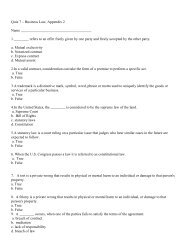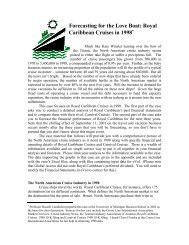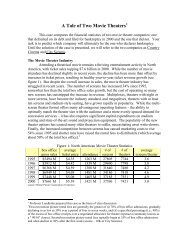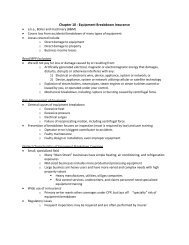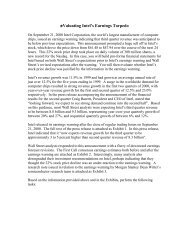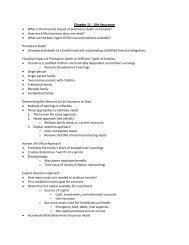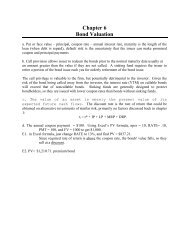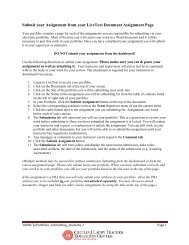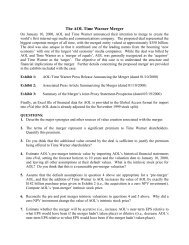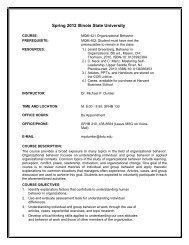Evaluating a Firm's External Environment - Illinois State University
Evaluating a Firm's External Environment - Illinois State University
Evaluating a Firm's External Environment - Illinois State University
Create successful ePaper yourself
Turn your PDF publications into a flip-book with our unique Google optimized e-Paper software.
M02_BARN4586_03_SE_C02.qxd 7/1/09 7:34 AM Page 45<br />
Chapter 2: <strong>Evaluating</strong> a Firm’s <strong>External</strong> <strong>Environment</strong> 45<br />
dominated by a small number of firms. In this setting, a firm has little choice but<br />
to purchase supplies from these firms. These few firms thus have enormous flexibility<br />
to charge high prices, to reduce quality, or in other ways to squeeze the profits<br />
of the firms to which they sell. Much of Microsoft’s power in the software<br />
industry reflects its dominance in the operating system market, where Windows<br />
Vista remains the de facto standard for most personal computers. For now, at least,<br />
if a company wants to sell personal computers, it is going to need to interact with<br />
Microsoft. It will be interesting to see if Linux-based PCs become more powerful,<br />
thereby limiting some of Microsoft’s power as a supplier.<br />
Conversely, when a firm has the option of purchasing from a large number<br />
of suppliers, suppliers have less power to threaten a firm’s profits. For example, as<br />
the number of lawyers in the United <strong>State</strong>s has increased over the years (up 40<br />
percent since 1981, currently over 1 million), lawyers and law firms have been<br />
forced to begin competing for work. Some corporate clients have forced law firms<br />
to reduce their hourly fees and to handle repetitive simple legal tasks for low<br />
flat fees. 31<br />
Second, suppliers are a greater threat when what they supply is unique or<br />
highly differentiated. There was only one Michael Jordan, as a basketball player,<br />
as a spokesperson, and as a celebrity (but not as a baseball player). Jordan’s unique<br />
status gave him enormous bargaining power as a supplier and enabled him to<br />
extract much of the economic profit that would otherwise have been earned by the<br />
Chicago Bulls and Nike. Currently, there is only one LeBron James. In the same<br />
way, Intel’s unique ability to develop, manufacture, and sell microprocessors<br />
gives it significant bargaining power as a supplier in the personal computer<br />
industry.<br />
The uniqueness of suppliers can operate in almost any industry. For example,<br />
in the highly competitive world of television talk shows, some guests, as suppliers,<br />
can gain surprising fame for their unique characteristics. For example, one woman<br />
was a guest on eight talk shows. Her claim to fame: She was the tenth wife of a gay,<br />
con-man bigamist. Talk show hosts can also exercise significant power as suppliers.<br />
King World, the distributor of the Oprah talk show, has depended on Oprah for as<br />
much as 40 percent of its revenues. This, of course, has given the show’s host,<br />
Oprah Winfrey, significant leverage in negotiating with King World. 32<br />
Third, suppliers are a greater threat to firms in an industry when suppliers<br />
are not threatened by substitutes. When there are no effective substitutes, suppliers<br />
can take advantage of their position to extract economic profits from firms they<br />
supply. Both Intel (in microprocessors) and Microsoft (in PC operating systems)<br />
have been accused of exploiting their unique product positions to extract profits<br />
from customers.<br />
When there are substitutes for supplies, supplier power is checked. In the<br />
metal can industry, for example, steel cans are threatened by aluminum and plastic<br />
containers as substitutes. In order to continue to sell to can manufacturers, steel<br />
companies have had to keep their prices lower than would otherwise have been<br />
the case. In this way, the potential power of the steel companies is checked by the<br />
existence of substitute products. 33<br />
Fourth, suppliers are a greater threat to firms when they can credibly<br />
threaten to enter into and begin competing in a firm’s industry. This is called<br />
forward vertical integration; in this situation, suppliers cease to be suppliers only<br />
and become suppliers and rivals. The threat of forward vertical integration is partially<br />
a function of barriers to entry into an industry. When an industry has high<br />
barriers to entry, suppliers face significant costs of forward vertical integration,



